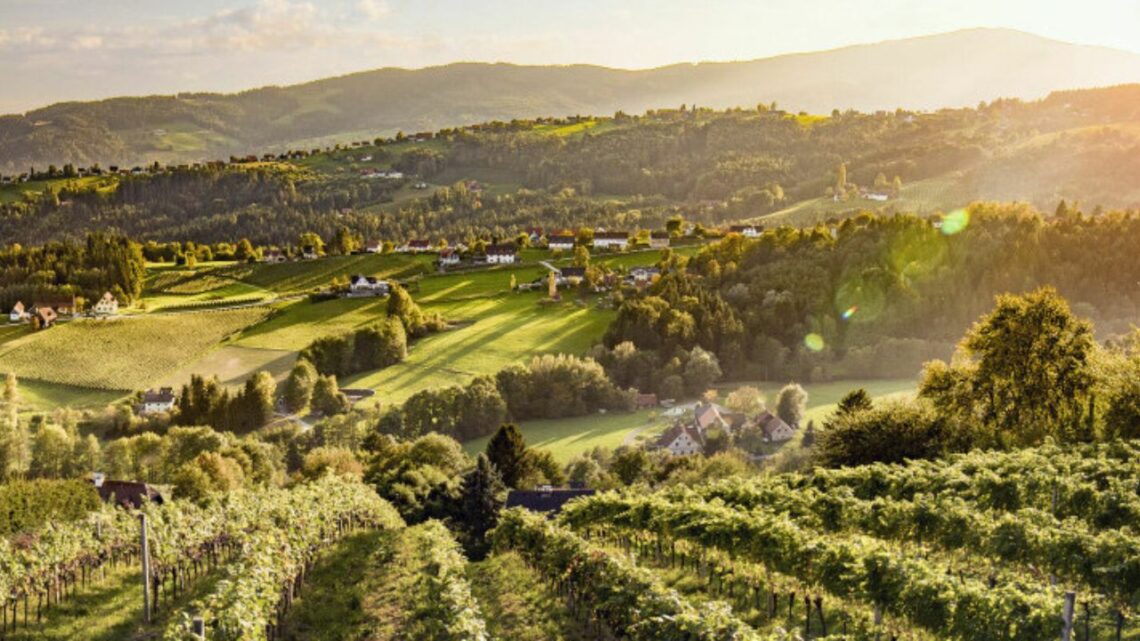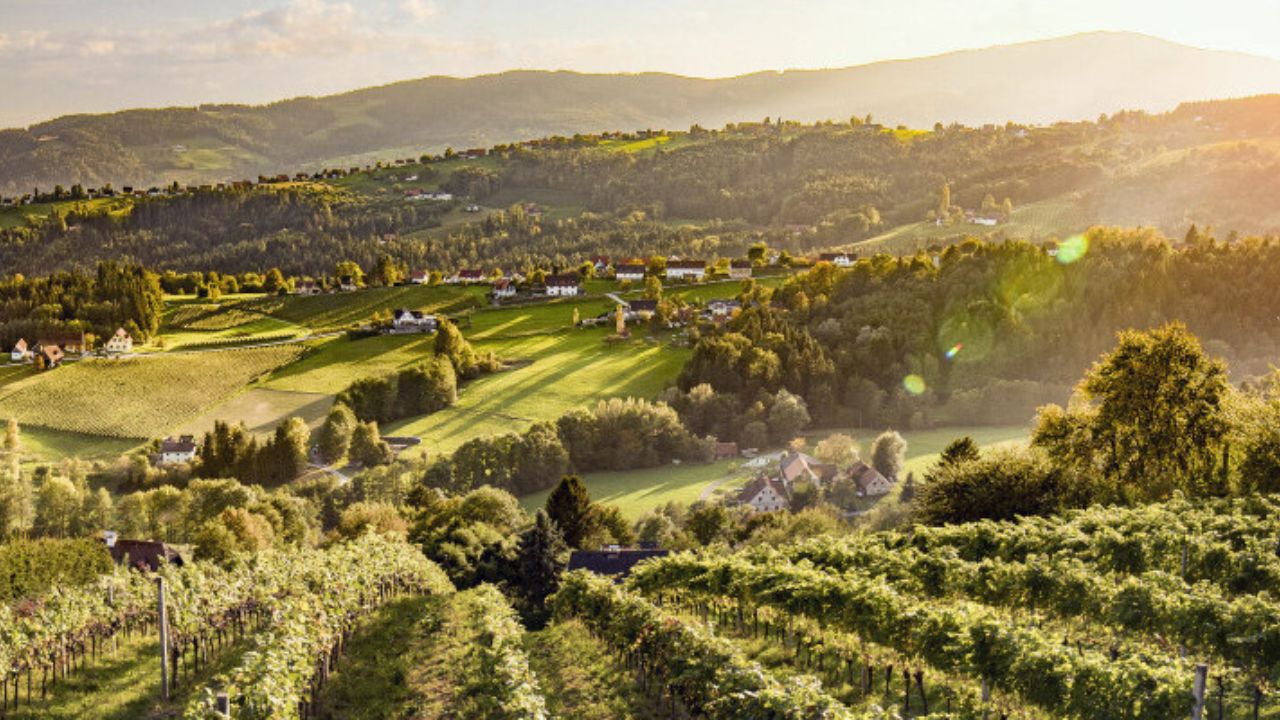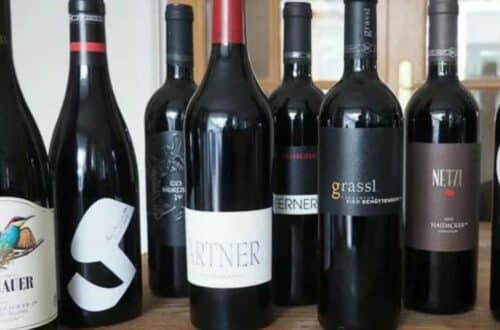
Steiermark wines
Located in the southern part of Austria, Steiermark is one of the country’s four main wine regions.
While Austria is renowned for its high-quality dry white wines, particularly Grüner Veltliner and Riesling, Styria presents different styles of wine with different grape varieties.
International grape varieties, such as Sauvignon Blanc and Chardonnay will dominate the scene.
Styria, a beautiful wine region in Austria, is known for its fresh and lively wines. Explore unique styles like Schilcher rosé in the west, Sauvignon Blanc in the south, and delicious Pinot Blanc throughout the region. And as it’s my favourite wine region, you should really read the whole post!
Steiermark overall presentation
Certainly, there are wine regions where more powerful and structured wines are produced. However, there is no other region in the world that offers fresher, more vibrant, and typically elegant grape varieties than in Southern Styria!
This applies to all three wine zones (Vulkanland, Weststeiermark, Südsteiermark) in Styria, each producing incomparable specialties, mostly located in the southern part of the administrative region.
Styria, with its 4,630 hectares of vineyards, is a picturesque region (is sometimes refered to as “Tuscany of the North”) known for its incredibly steep vineyards. The majority of vineyards are located in the southern sectors, where evidence suggests that the Celts were cultivating grapes, a practice that was continued by the Romans.
However, the turbulent wars and plagues of the 16th and 17th centuries resulted in a decline of viticulture. It was not until the 1840s that Archduke Johann, banished to Styria for marrying a commoner and engaging in political activities frowned upon by his Habsburg relatives, revived winemaking. He established a research institute in the region, based in Maribor (now in Slovenia).
In Styria, the new vintage is traditionally celebrated with the light-bodied “Junker” wine, served from early November. The dry Gebietsweine are released starting from March of the following year. Wine enthusiasts have to wait a little longer to taste the Ortsweine and Riedenweine.
Terroir : climate and soil
Approximately three-quarters of Styrian vineyards grow on sedimentary deposits in the Styrian Basin, while 20 percent of the vines root in the hard rocks of the Austroalpine. A small percentage is found on often coarse fluvial sediments that accumulate in the basin.

The southeastern part of Styria is characterized by basalts, volcanic scoria, and tuffs, which account for about three percent of Styrian vineyards. Other sediments range from silts and marls to sands and blocks, gravels, tuffeaux, and conglomerates, with occasional presence of limestone.
Styria faces challenges due to its harsh climate, with temperatures dropping as low as -20 degrees Celsius. It is also a wet region, and erosion is a problem, particularly in the steep vineyards. This of course can be a problem because it encourages diseases, such as mildew. Depending on whether the region is exposed to the Alps and or the Adriatic sea, climate conditions vary significantly.
Among its sub-regions, Südsteiermark has the largest surface area of vineyards
Grapes varieties in Steiermark
White wines dominate the Styrian wine scene, with varieties such as Sauvignon Blanc, Chardonnay (or Morillon), Weissburgunder, Grauburgunder, Gelber Muskateller, and Traminer.
ANECDOTE : Sauvignon Blanc was brought by Archduke Johann in the 1820s. Affectionately known as the Prince of Styria or People’s Prince, the Archduke, who married a commoner and was exiled to the region, dedicated himself to sharing the latest knowledge in agriculture, viticulture, and technology with the local people. As a result, they became some of the most progressive peasants in the world during that era.
Styrian white wines are invigorating and refreshing, and winemakers often take a more subtle approach to oak aging.
Styrians take pride in their traditions, and since 2006, the Gross estate has revived the use of Stettin (or Startin) barrels, which have a capacity of 565 liters and are crafted from Styrian oak.
Half-sized barrels known as Halm are also used.
These barrels have unique dimensions as they were designed to hold the must from 10 Eimer (buckets) of grapes brought in by harvesters. Notably, Stettin and Halm barrels have thick staves and are lightly toasted.
The DAC in Steiermark
The 2018 vintage marked a new era for Styrian wines. All three wine zones obtained the DAC appellation: Vulkanland Steiermark DAC, Südsteiermark DAC, and Weststeiermark DAC.
The respective typical white wines, including Schilcher in Western Styria, are presented in three categories: Gebietswein, Ortswein, and Riedenwein.
The whole range of the grape varieties listed above can be used. However, Ortsweine and Riedenweine tend to focus on local grape varieties.
The region is also home to notable groups and associations. The “Schmecke das Leben” group comprises natural-wine producers such as Strohmeier, Tauss, Wertlitsch, Andreas Tscheppe, and Sepp Muster.
Additionally, the STK (Steirische Terroir- und Klassikweingüter), similar to the Traditionsweingüter of Lower Austria, has established its own hierarchy with categories like Erste Lage and Grosse Lage. Member wineries include Gross, Lackner-Tinnacher, Neumeister, Polz, Sattlerho, Tehment, Frauwallner, Wohlmuth, Hannes Sabathi, Erwin Sabathi, Maitz, and Winkler Hermaden.
The registered “STK” designation can be applied to wines from different vineyards and regions, provided they meet the criteria described below that extend beyond mere geographical boundaries.
Before we get to these criteria, a short note on the vineyards : here, the vineyards are much bigger than in the Wachau for instance. With the many hills in Steiermark, the vineyards have microclimates within (depending on the exposition, altitude…). Thus, wines from one vineyard can differ a lot depending on where the vines are located in the vineyards. However, what stays the same in each vineyard is the soil. So the best way to guess where a wine comes from is to know the soils of the vineyards.
Due to these large vineyards, in contrast to other wine regions, where a Grand Cru is a physically separate place with a distinct name from a Premier Cru, here, a Grand Cru and a Premier Cru can share the same name, representing essentially the same vineyard. The differentiation is based on additional criteria detailed below.
**Grosse Lage / Grand Cru:**
These wines come from the finest single-vineyards. Grapes must reach full ripeness, harvested later than those from other levels, resulting in heightened concentration and aging potential.
Vines are required to be a minimum of 15 years old—an uncommon specification in ranking systems. Yields are limited to 4,500 hl/h, and the wines must undergo a minimum aging period of 18 months (remarkably long for white wines) before release.
An intriguing stipulation is that only a cuvée present in the market for at least a decade, showcasing its potential for extended aging, can bear the Grosse Lage label. This criterion, according to the organization, ensures exceptional quality.
**Erste Lage / Premier Cru:**
Similarly originating from single-vineyards, these wines feature fully ripe grapes, offering increased concentration and aging potential.
Vines must have a minimum age of twelve years, with limited yields (4,500 hl/h). The wines must undergo a minimum aging period of one year and have proven themselves in prior vintages, demonstrating the potential to mature for at least five years.
The different part and wine styles of Steiermark
To the west of these exceptionally charming hills, Schilcher wines dominate, known for their distinctive rosé style and strong regional character.
In Sausal and along the South Styrian Wine Road, Sauvignon Blanc and Muscat Blanc à Petits Grains set the tone, while in the volcanic region of Vulkanland Steiermark in the southeast, these grape varieties are complemented by the highly appreciated Traminer.
The most widespread Styrian wine, Welschriesling, offers a bouquet reminiscent of green apples, which is very refreshing.
For those who enjoy luscious wines, Pinots would be preferred, such as Pinot Blanc from limestone soils. Chardonnay, also known as Morillon in the region, can be full-bodied despite its freshness, particularly when matured for an extended period, similar to the gray Burgundies (Ruländer, Pinot Gris).
Conclusion : Steiermark wines
Steiermark, also known as Styria, is a picturesque wine region in Austria known for its fresh, vibrant, and elegant grape varieties. With 4,630 hectares of vineyards, the majority located in the southern part of the region, Steiermark offers incomparable specialties across its three wine zones: Vulkanland, Weststeiermark, and Südsteiermark.
The region has a rich viticultural history, with evidence of grape cultivation dating back to the Celts and Romans. However, wars and plagues in the 16th and 17th centuries led to a decline in viticulture. It was later revived in the 1840s by Archduke Johann, who established a research institute in the region.
The region offers a range of wine styles, from the distinctive rosé Schilcher wines in the west to Sauvignon Blanc and Muscat Blanc à Petits Grains in Sausal and along the South Styrian Wine Road. The volcanic region of Vulkanland Steiermark complements these with highly appreciated Traminer wines. Welschriesling, known for its refreshing green apple bouquet, and luscious Pinot Blanc and Chardonnay wines are also prominent in the region.
In 2018, all three wine zones in Steiermark obtained the DAC (Districtus Austriae Controllatus) appellation, introducing the Vulkanland Steiermark DAC, Südsteiermark DAC, and Weststeiermark DAC. These appellations define the typical white wines and present them in three categories: Gebietswein, Ortswein, and Riedenwein. Local grape varieties often take the spotlight in Ortsweine and Riedenweine.
Crafting wine in this picturesque location is great, yet far from effortless. The vineyards are too steep and the soil too moist for machinery, requiring vineyards to be tended predominantly by hand. This hands-on approach directly contributes to the exceptional quality of the wine produced.







